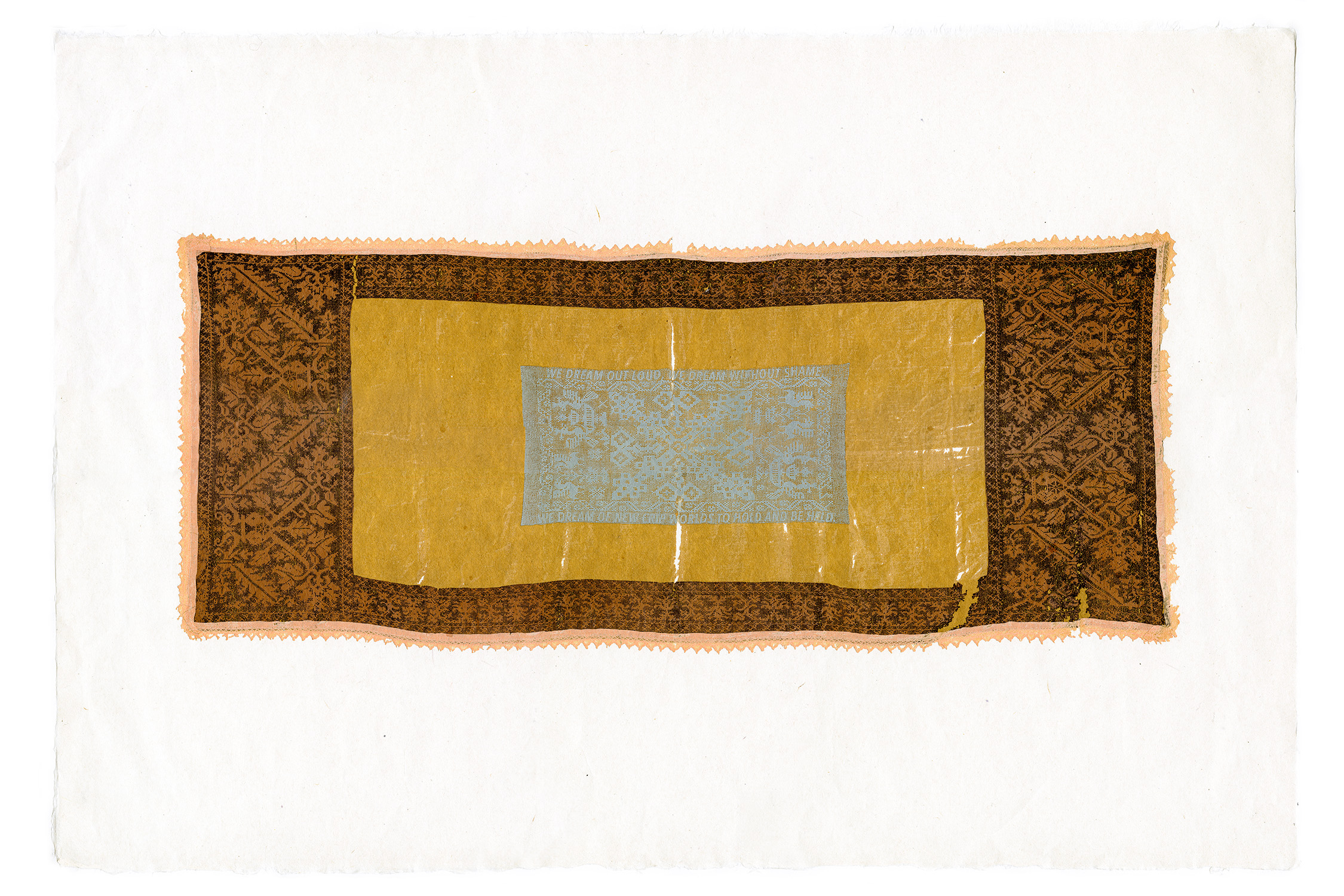Image Credit: Chelsey Campbell
a garland for patty, 2022
Laser-engraved Moriki Kozo, Oguni Kakishibugami, and Chiri Kozo tissue on heritage washi paper
Image Description: Suspended on a white gallery wall by way of two circular magnets, a delicate scarf rests on a sheet of handmade paper. An assemblage of warm ochres, fleshy pinks and the rich hue of persimmon baked in the heat of the afternoon sun, the scarf is warm and inviting, beckoning us closer. The textile edges are worn with only remnants of the salmon-pink fringe remaining in tact. Despite the obvious wear, the piece feels loved, draped to showcase the interlocking fibres of the careful needlework. In the center of the scarf is the innermost of three rectangles. Gray-ish blue and containing a decorative patterning that contrasts against the ochre’s warmth, the rectangular space visually vibrates as the colours clash and integrate. Emerging from this clattering of ochre and slate blue are the words ‘WE DREAM OUT LOUD, WE DREAM WITHOUT SHAME, WE DREAM OF CRIP WORLDS TO HOLD AND BE HELD,’ embroidered just within the rectangle’s horizontal borders.
WORK STATEMENT
The intimate embrace of the warp and weft in textiles are like our crip care networks; each thread, every stitch, is made stronger by its interconnectedness to one another. Sourcing text from disabled writers, conversations with my community, as well as personal journal entries from the pandemic, each cloth is etched with a fragment of our story — a narrative thread captured on the surface. Utilizing a laser engraver to critically expose the warp and weft of the handkerchief, each cloth requires a delicate touch to keep the text from fraying and disintegrating from the surface of the weave. The fragile state of the handkerchief mirrors the tender state of our stories, of recovery and care. In this work, the text is inspired by Sins Invalid’s co-founder Patty Berne’s tender forward in Shayda Kafai’s Crip Kinship. I hold her/their words so close, like a comforting shawl weighing down and enrobing my bodymind in the expansive warmth of crip beauty. An offering, a warm embrace, an invitation to dream.
ARTIST STATEMENT
The stories we share with each other are transformative, planting seeds of resistance and radical tenderness while tending networks of kinship and care. My research-creation practice centres crip storytelling as queer alchemy, a critical tool in transforming intersecting oppressions into evidence of chronically ill, mad, d/Deaf, neurodivergent, sick and disabled ingenuity, joy, beauty, and community. Folding together conversations and collaborations with crip community, my work centres and amplifies the tender words of queer femmes of colour whose expansive generosity and kindness lead the Disability Justice movement. Through tenacious vulnerability, crip storytelling makes visible our struggles and hopes while holding space for kinship and connection.
Utilizing Norman Denzin’s framework of performance autoethnography, my practice moves “back and forth between the personal and the political, the biographical and the historical” to stimulate collective political imagination. Weaving together rituals of care, rest, and sustainability with printmaking, fabrication, 3D modelling, textiles, installation, and photography, my transdisciplinary research practice is activated by and for crip community. Through the alchemy of care and community, roots spread slowly, patiently, deeply. Planted in love and growing closer through the expansive and intertwined networks of our kinship.
Artist Bio
Chelsey Campbell (they/she) is a queer crip artist, educator, and cultural worker. A nonbinary white settler of Scottish descent, Campbell graciously resides as an uninvited guest in amiskwacîwâskahikan (or so-called Edmonton) on Treaty 6 Territory. Exploring tender narratives of disability justice, feminized care labour, and crip kinship, their practice intertwines autoethnographic storytelling with community-oriented practices of access, care, and interdependence. Through a combination of printmaking, 3D modelling, installation, and photography, their work seeks to make space for the body in pain, celebrate disabled narratives as complex and whole, and build radical access for community through artistic practice.
